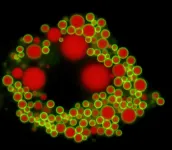(Press-News.org) Hitting a pothole on the road in just the wrong way might create a bulge on the tire, a weakened spot that will almost certainly lead to an eventual flat tire. But what if that tire could immediately begin reknitting its rubber, reinforcing the bulge and preventing it from bursting?
That's exactly what blood vessels can do after an aneurysm forms, according to new research led by the University of Pittsburgh's Swanson School of Engineering and in partnership with the Mayo Clinic. Aneurysms are abnormal bulges in artery walls that can form in brain arteries. Ruptured brain aneurysms are fatal in almost 50% of cases.
The research, recently published in Experimental Mechanics, is the first to show that there are two phases of wall restructuring after an aneurysm forms, the first beginning right away to reinforce the weakened points.
"Imagine stretching a rubber tube in a single direction so that it only needs to be reinforced for loads in that direction. However, in an aneurysm, the forces change to be more like those in a spherical balloon, with forces pulling in multiple directions, making it more vulnerable to bursting," explained Anne Robertson, professor of mechanical engineering and materials science at Pitt, whose lab led the research. "Our study found that blood vessels are capable of adapting after an aneurysm forms. They can restructure their collagen fibers in multiple directions instead of just one, making it better able to handle the new loads without rupturing."
Researchers have known that blood vessels have the ability to change and restructure over time, but this study represents the first observation of a new, primary phase of restructuring that begins immediately.
The researchers used a rabbit model developed by David Kallmes of the Mayo Clinic to observe this restructuring in the brain tissue over time. To see this process up close, the researchers partnered with Simon Watkins at Pitt's Center for Biologic Imaging, taking advantage of the center's state-of-the-art multiphoton microscopes to image the architecture of the fibers inside the aneurysm wall.
"We found that the first phase of restructuring involves laying down an entirely new layer of collagen fibers in two directions to better handle the new load, while the second phase involves remodeling existing layers so their fibers lie in two directions," explained Chao Sang, who was a primary investigator on this research as part of his doctoral dissertation in Pitt's Department of Mechanical Engineering and Materials Science
"The long-term restructuring is akin to a scar forming after a cut has healed, while this first phase that we observed can be thought of as having a role similar to clotting immediately after the cut--the body's first response to protect itself," added Robertson, who has a secondary appointment in the Swanson School's Department of Bioengineering. "Now that we know about this first phase, we can begin to investigate how to promote it in patients with aneurysms, and how factors like age and preexisting conditions affect this ability and may place a patient at higher risk for aneurysm rupture."
INFORMATION:
The investigative team includes Robertson and graduate students Chao Sang and Michael Durka from Pitt, Simon Watkins from the Center for Biologic Imaging, and David Kallmes, Ramanathan Kadirvel, Yong Hong Ding, and Daying Dai from the Mayo Clinic's Department of Radiology.
The paper, "Adaptive Remodeling in the Elastase-Induced Rabbit Aneurysms," (DOI:10.1007/s11340-020-00671-9) was published in the journal Experimental Mechanics and was authored by Chao Sang, Michael Durka and Anne Robertson at the Swanson School; David Kallmes, Ramanathan Kadirvel, Yong Hong Ding and Daying Dai at the Mayo Clinic's Department of Radiology; Simon Watkins at Pitt's Center for Biologic Imaging.
PHILADELPHIA (January 25, 2021) - While eating less and moving more are the basics of weight control and obesity treatment, finding ways to help people adhere to a weight-loss regimen is more complicated. Understanding what features make a diet easier or more challenging to follow can help optimize and tailor dietary approaches for obesity treatment.
A new paper from the University of Pennsylvania School of Nursing (Penn Nursing) analyzed different dietary approaches and clinical trials to better understand how to optimize adherence and subsequent weight reduction. The findings have been published in the Journal of Clinical Investigation.
"There is not convincing evidence that one diet is universally easier to adhere to than another for extended periods, a feature necessary for long-term ...
Research by an international team of medical experts has found cancer patients could be up to four times more likely to die following cancer surgery in low to lower-middle income countries than in high-income countries. It also revealed lower-income countries are less likely to have post-operative care infrastructure and oncology services.
The global observational study, published in The Lancet, explored global variation in post-operative complications and deaths following surgery for three common cancers. It was conducted by researchers from the GlobalSurg Collaborative and NIHR Global Health Unit on Global Surgery - led by the University of Edinburgh, with analysis and support from the University of Southampton.
Between April 2018 and January 2019, researchers enrolled 15,958 ...
COLUMBUS, Ohio - Older minority cancer patients with poor social determinants of health are significantly more likely to experience negative surgical outcomes compared to white patients with similar risk factors, according to a new study published by researchers at The Ohio State University Comprehensive Cancer Center - Arthur G. James Cancer Hospital and Richard J. Solove Research Institute (OSUCCC - James).
A new retrospective analysis of more than 200,000 patients conducted by researchers with the OSUCCC - James suggests that minority patients living in high socially vulnerable neighborhoods had a 40% increased risk of a complication ...
CHAMPAIGN, Ill. -- Absent a widely available vaccine, mitigation measures such as stay-at-home mandates, lockdowns or shelter-in-place orders have been the major public health policies deployed by state governments to curb the spread of COVID-19.
But given the uncertain duration of such policies, questions have been raised about the potential negative mental health consequences of extended lockdowns with indefinite end dates. But according to new research co-written by a team of University of Illinois Urbana-Champaign experts who study the intersection of health care and public policy, the negative mental health effects of ...
ITHACA, N.Y. - Researchers from Cornell University and the National Park Service have pinpointed and confirmed the location of the remnants of a wooden fort in Alaska - the Tlingit people's last physical bulwark against Russian colonization forces in 1804 - by using geophysical imaging techniques and ground-penetrating radar.
The fort was the last physical barrier to fall before Russia's six-decade occupation of Alaska, which ended when the United States purchased Alaska in 1867 for $7 million.
The Tlingit built what they called Shiskinoow - the "sapling fort" - on a peninsula in modern-day Sitka, Alaska, ...
During epileptic seizures, a large number of nerve cells in the brain fire excessively and in synchrony. This hyperactivity may lead to uncontrolled shaking of the body and involve periods of loss of consciousness. While about two thirds of patients respond to anti-epileptic medication, the remainder is refractory to medical treatment and shows drug-resistance. These patients are in urgent need for new therapeutic strategies.
Together with colleagues in Japan, Prof. Dr. Christine Rose and her doctoral student Jan Meyer from the Institute of Neurobiology at HHU have performed a study to address the cellular mechanisms that promote the development of epilepsy. While up to now, most studies and anti-epileptic drugs targeted nerve cells (neurons), ...
Findings of a new study published by researchers from Trinity College Dublin and St James's Hospital outline the health impacts faced by older people while cocooning during the Covid-19 pandemic. The findings are published in the Quarterly Journal of Medicine here: https://bit.ly/3qGKJoI.
Cocooning involves staying at home and reducing face-to-face interaction with other people and is an important part of the response to the COVID-19 pandemic, with an overall aim to prevent transmission to vulnerable older people. However, concerns exist regarding the long-term adverse effects ...
A new study from Indiana University researchers finds that most high-school age youth are willing to wear masks to help prevent the spread of the COVID-19 virus, but that more education is needed on how to wear masks properly and on the importance of consistent commitment to public health guidelines.
The study, published today in the Journal of Adolescent Health looked at 1,152 youth's mask wearing and social distancing behaviors during five, in-person live-streamed high school graduations from one U.S. public school district in early July 2020. These broadcasts allowed the researchers to systematically document social-distancing behaviors throughout the ceremonies and mask-wearing as students crossed the graduation stage ...
Coconut oil has increasingly found its way into German kitchens in recent years, although its alleged health benefits are controversial. Scientists at the University of Bonn have now been able to show how it is metabolized in the liver. Their findings could also have implications for the treatment of certain diarrheal diseases. The results are published in the journal Molecular Metabolism.
Coconut oil differs from rapeseed or olive oil in the fatty acids it contains. Fatty acids consist of carbon atoms bonded together, usually 18 in number. In coconut oil, however, most of these chains are much shorter and contain only ...
Research from North Carolina State University shows that extreme weather events, such as hurricanes and increased precipitation, affect both the amount and the composition of picophytoplankton in the Neuse River Estuary. The work is a first step in determining how a wetter climate may affect the estuarine ecosystem.
Picophytoplankton are defined as any phytoplankton measuring less than three micrometers in size. Although well studied as part of the oceanic ecosystem and food web, picophytoplankton are understudied in estuarine systems, even though they occur in significant numbers within these environments.
"Picophytoplankton are important primary producers in aquatic ecosystems," says Ryan Paerl, assistant professor of ...




